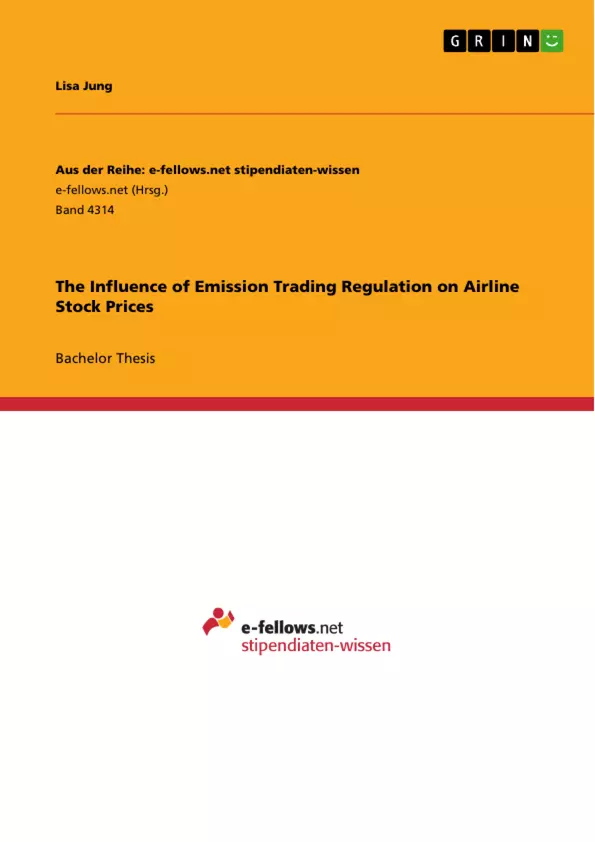The introduction of an emission trading system within the European Union from 2012 on represents a major financial barrier for all airlines, especially those operating their hubs inside the EU. While the plan is to request all airlines flying in the EU to buy emission certificates, most non-European carriers could still benefit from the international disputes going on at the moment. European-based airlines in turn fear a disadvantage against their non-european competitors, as the need for emission certificates will burden their already high cost structures even further.
The paper should first explain the concept of emission trading schemes as well as the current plan of introducing emission trading in the European Union. The second part will then elaborate on the airline’s perspective on emission trading and the included risks/ disadvantages originating from an introduction of such a system. A third part will then analyze the correlation between announcements concerning the emission trading system and the performance of airline stock prices. The analysis shall be based on the stock performance of major European airlines, as they will be the ones facing major discrimination if the system gets introduced. Finally, the usefulness of an emission trading system is going to be discussed and alternatives to solve the climate change issue will be presented.
Inhaltsverzeichnis (Table of Contents)
- Introduction
- Background
- Problem Definition and Objective
- Course of Investigation
- Aviation and Climate Change
- The Environmental Impact of Aviation Emissions
- Potential Climate Change Mitigation Measures
- Technological Innovation
- Operational Efficiency
- Infrastructure Improvements
- Economic Measures
- Emission Trading Regulation in Aviation
- The Inclusion of Aviation in the EU ETS
- Design of the EU ETS
- Underlying Policy Objectives
- Influence on Airline Performance and Competition
- The EU ETS in the International Context
- Legal Framework
- The International Communities' Perspective on the EU ETS
- Current Developments in Global Emission Trading Regulation
- The Influence of Emission Trading Regulation on Airline Stock Prices – an Event Study
- The General Logic of Event Studies
- Application of Event Studies to Regulatory Changes – Special Challenges
- Methodology of the Event Study on Aviation in the EU ETS
- Result Presentation
- Result Interpretation and Discussion
- Conclusion
- Limitations of the Work
- Outlook and Future Research Suggestions
- Conclusion
Zielsetzung und Themenschwerpunkte (Objectives and Key Themes)
This thesis investigates the influence of emission trading regulations on airline stock prices. The primary objective is to analyze the impact of the European Union's Emission Trading System (EU ETS) on the stock performance of airlines included in the scheme. By utilizing an event study methodology, the research aims to assess the market reaction to the introduction and subsequent developments of the EU ETS.
- The environmental impact of aviation emissions and the need for climate change mitigation measures
- The design, implementation, and impact of the EU ETS on airline performance and competition
- The influence of regulatory changes on airline stock prices, particularly within the context of the EU ETS
- The challenges and limitations of event study methodology in the context of regulatory changes
- The international context of emission trading regulation and the implications for global aviation
Zusammenfassung der Kapitel (Chapter Summaries)
- Introduction: This chapter sets the scene by providing background information on aviation emissions and the importance of addressing climate change. It introduces the research problem and objectives, outlining the scope and methodology of the study.
- Aviation and Climate Change: This chapter discusses the environmental impact of aviation emissions, highlighting the significant contribution of the sector to global greenhouse gas emissions. It explores potential climate change mitigation measures, including technological innovations, operational efficiency improvements, infrastructure development, and economic measures.
- Emission Trading Regulation in Aviation: This chapter delves into the inclusion of aviation in the EU ETS, examining its design, underlying policy objectives, and influence on airline performance and competition. It also considers the international context of emission trading, including legal frameworks, perspectives of the international community, and current developments in global emission trading regulation.
- The Influence of Emission Trading Regulation on Airline Stock Prices – an Event Study: This chapter introduces the concept of event studies and its application to analyze the impact of regulatory changes on stock prices. It outlines the methodology used in the study, focusing on the specific challenges of applying event studies to regulatory changes in the aviation sector. This chapter also presents and discusses the results of the event study, analyzing the market reaction to the EU ETS.
Schlüsselwörter (Keywords)
This thesis focuses on the impact of emission trading regulations on airline stock prices, specifically examining the European Union Emission Trading System (EU ETS). Key concepts explored include climate change, aviation emissions, environmental regulation, event study methodology, market efficiency, and the impact of regulatory changes on stock performance. The research also considers international perspectives on emission trading regulation and its implications for global aviation.
- Citar trabajo
- Lisa Jung (Autor), 2012, The Influence of Emission Trading Regulation on Airline Stock Prices, Múnich, GRIN Verlag, https://www.grin.com/document/1401382



